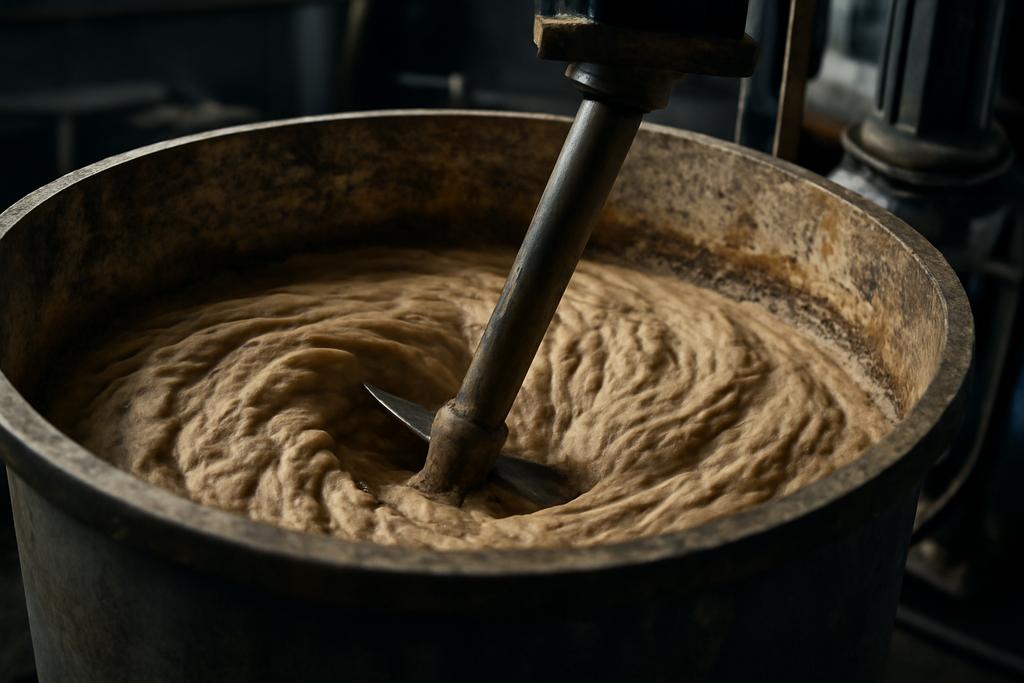In industrial mixing, chaos isn’t a bug—it’s a feature. When fluids are thick and surfaces are rough, simply spinning harder or longer doesn’t always produce a better blend. The trick is to shake up the flow in a way that stretches, folds, and reshapes the liquid interface, like kneading dough with a mischievous twist. That’s the idea behind chaotic mixing, a field that treats unpredictability as a tool to achieve faster, more uniform distribution of solids in liquids.
Researchers led by Ronfgang Wang at Chang’an University in Xi’an—home to the Key Laboratory of Highway Construction Technology and Equipment—worked with Detong Intelligent Technology Co. to test a deliberately off-center stirring setup. By offsetting the shaft and dialing in different rotation speeds, they bent the flow into asymmetric patterns. The goal wasn’t poetry but performance: could a dash of chaos shave time off the job and make the dye spread more evenly?
What makes this study memorable is how they measured chaos. Rather than relying on abstract simulations alone, they watched a dye tracer as it smeared through a viscous liquid and, separately, listened to the sound of collisions and slaps inside the tank. Then they linked those observations with nonlinear time-series analysis to quantify chaotic dynamics through a Lyapunov exponent. The punchline is surprisingly tangible: sound and sight can reveal when chaos is helping you mix faster and more uniformly.
What eccentric mixing does to chaos
Traditional center stirring keeps the flow neatly symmetrical. Eccentric stirring, by contrast, tilts the flow away from center and stirs the pot in irregular ways. This symmetry breaking creates chaotic pockets—vortices that become shallower, more numerous, and less predictable. In practical terms, there are more opportunities for dye to chase every corner of the liquid, but there are also more chances for the flow to trap itself in complex loops.
As the eccentricity e and the rotation speed N grow, the response is nonmonotonic. The mixing time can dip as chaos intensifies, then rebound as the chaotic motion becomes counterproductive for transport. The takeaway is that more chaos isn’t automatically better; there exists a sweet spot where the chaos actively accelerates the homogenization rather than stalling it in recirculating swirls.
Quantitatively, the optimal regime shows up near E/R ≈ 0.4 and N ≈ 450 rpm. In that neighborhood, the researchers observed a mixing-time reduction of about 48% compared with center stirring, a striking gain that persisted across the tested liquids. Glycerol, being more viscous than water, exhibited different vortex shapes, but the overall pattern held: a moderate offset and a brisk, controlled spin produced a faster, more thorough mix.
Measuring chaos with sound and dye
To visualize mixing, the team used a dye tracer and grayscale image analysis. They injected a small amount of red dye and tracked how the region of interest labeled L colored up over time—the slowest part of the tank to mix. By converting the liquid’s color to gray levels, they could pinpoint the moment when that region reached a stable, uniform appearance, turning mixing time into a concrete, image-based milestone.
But the more provocative part of the study was the acoustic angle. A sound sensor recorded the decibel levels as the stirrer whirred and the liquid’s surface and walls rang with impact and splash. After filtering out noise, the researchers treated the decibel time series as a nonlinear signal. Drawing on the Wolf algorithm and Takens’ embedding, they reconstructed the phase space and measured the largest Lyapunov exponent—the standard gauge of chaos.
Crucially, the decibel-based chaos index tracked the same peak of chaotic mixing that the image-based mixing time identified. The best chaos signal occurred near e = 0.4 and 450 rpm, and the high-LLE regime aligned with the shortest mixing times. The authors argue that everyday sound can serve as a low-cost, real-time readout of a mixer’s chaotic state, offering a practical way to monitor and control industrial devices without invasive sensors. The idea is seductive: the mixer itself becomes a tiny laboratory, whispering its own complexity through the room’s acoustics.
Why it matters and what comes next
Beyond the novelty, the study sketches a pathway toward smarter, more efficient mixers. The team introduced a dimensionless chaos index M that ties together eccentricity, rotation, and fluid properties like density and viscosity. In the right context, M could serve as a quick guide to how far a given setup sits from the chaos optimum, guiding operators to tune speed or offset in real time to stay in the sweet-spot regime. In other words, chaos isn’t just a concept in the lab—it could become a practical knob on the factory floor.
If the idea scales, the payoff is meaningful: shorter mixing times reduce energy usage and wear on equipment, while promoting more uniform products in sectors from ceramics and catalysts to paints and pharmaceuticals. The study’s focus on the slowest-to-mix region L is a practical reminder that you don’t just mix the average liquid—you need to finish the job where the flow seems stubborn.
Of course, there are caveats. The experiments took place in a compact, transparent cylinder with simple geometry, and the fluids were straightforward water–glycerol blends. Real-world tanks sport baffles, heat exchange, multi-component mixtures, and noisy operations. The authors acknowledge that translating M and the precise sweet spot to industry will require broader testing, different geometries, and scaling up. Still, the central idea is robust: by embracing and measuring chaos, engineers can design mixers that are both faster and gentler on energy use.










